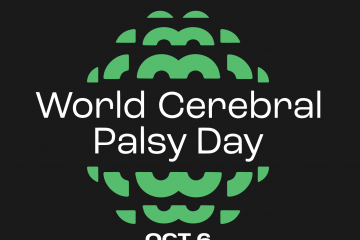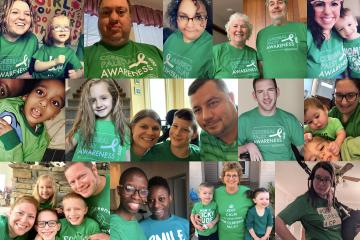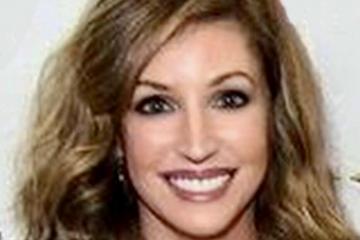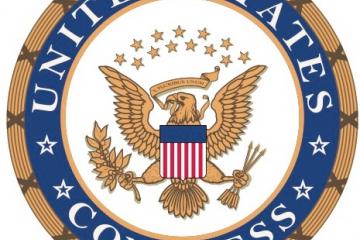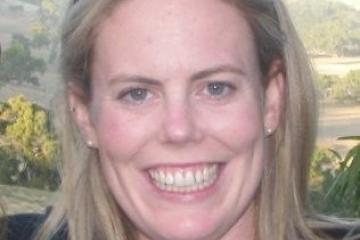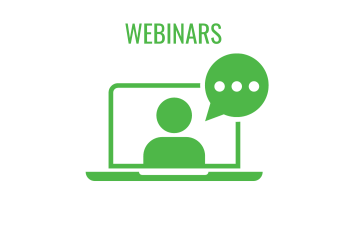Congressional Briefing for Cerebral Palsy
The need for cerebral palsy research investment is more critical than ever. Cerebral palsy is the most common lifelong physical disability, impacting more than 1,000,000 Americans and 1 in 345 American children, yet is significantly underfunded across the lifespan.
Most Americans aren't aware of how common cerebral palsy is and how little research is being conducted compared to the number of Americans affected. Many people don't realize that the economic and healthcare cost of cerebral palsy is estimated to be more than one trillion dollars- which can be reduced with better prevention, earlier detection, more effective treatments and comprehensive standards of care across the lifespan.
On March 29th, 2022 Congressman Steve Cohen (TN)), with bipartisan co-sponsors Congressmen Brian Fitzpatrick (PA) and Emanuel Cleaver (MO), introduced the Cerebral Palsy Research Program Act (HR 7265) which would create a cerebral palsy research program within the Centers for Disease Control and Prevention (CDC) and provide the first-ever dedicated source of federal funding for cerebral palsy research.
The Cerebral Palsy Foundation is proud to support the development of and introduction of this pivotal piece of legislation that will improve the lives of millions of Americans living with cerebral palsy and their families. Please visit our cerebral palsy advocacy and education website www.gogreen4cp.orgto learn more about the Cerebral Palsy Research Program Act, other legislative updates and how you can make a difference.
Rachel Byrne:
Welcome everyone to the first congressional briefing for cerebral palsy. My name is Rachel Byrne, the executive director for the Cerebral Palsy Foundation, a leading US nonprofit organization with a focus on improving the lives of people with cerebral palsy across their lifespan. We partner with researchers, clinicians, industry, and the cerebral palsy community to increase research that will speed treatments and drive changes that matter most to people living with cerebral palsy. I am also a physical therapist by training and a researcher, and will be your moderator. Today, we are pleased to have this opportunity during national cerebral palsy awareness month to share with you the critical need for cerebral palsy research from the perspective of families, patients, clinicians, and researchers. For those of you who may not be aware, cerebral palsy is the most common, lifelong physical disability impacting more than 17 million people around the world and over 1 million people here in the United States.
As common as cerebral palsy is, cerebral palsy receives very little research investment in the United States. The truth is that the low research investment has resulted in much lower progress in prevention, diagnosis, treatment advances, and care guidelines for those living with cerebral palsy. The need is great and the time is now to make a difference. I am honored to introduce Senator Maggie Hassan, who is only the second woman in American history to be elected both governor and United States Senator. Senator Hassan was drawn to public service as an advocate fighting to ensure that children like her son who has severe cerebral palsy, will be fully included in their communities and have the same opportunities that all parents want for their children.
Senator Maggie Hassan:
Hello, I'm Senator Maggie Hassan, from New Hampshire. As we mark National Cerebral Palsy Awareness Day, I want to thank the Cerebral Palsy Foundation and all of the advocates here for your efforts to raise awareness about this condition. This is an issue that is deeply personal for my family. My adult son, Ben was born with cerebral palsy and experiences severe physical disabilities. I know what an important role advocates have played and continue to play in ensuring that those with disabilities can participate fully in their communities. I appreciate your continued advocacy.
More than 1 million Americans live with cerebral palsy, which is why we must continue pushing to invest in research and help improve the quality of life for individuals and families who are impacted. As a member of the Senate Health Education, Labor and Pensions Committee I'll keep working with my colleagues to provide this funding. And I look forward to continuing to work with advocates like all of you. Thank you again to the Cerebral Palsy Foundation for your important work and stay safe.
Rachel Byrne:
Thank you, Senator Hassan for your continued support. Our next speaker is Congressman Steve Cohen. Congressman Steve Cohen is a fourth generation Memphian who has dedicated his life to public service. As a child the challenges of living with polio taught him how to overcome obstacles through persistence and determination. Values, which shape his 24 year career as a legislator working to improve the lives of people in Memphis, across Tennessee, and now across America, throughout his career in national, state and local politics. Thank you, Congressman Steve Cohen.
Congressman Steve Cohen:
Thank you for that kind introduction, Rachel. I really appreciate it. It's good to be with you this afternoon. I want to thank everybody involved with the Cerebral Policy Foundation for coordinating this briefing and for inviting me to speak as well. And most importantly, for what you're doing for the people with cerebral palsy. It's such a important issue. And we need to keep our eyes on the prize.
Our other speakers, I thank particularly Dr. William Warner from Le Bonheur Children's Hospital here in Memphis. Cerebral palsy is the most prevalent lifelong physical disability occurring in approximately 1 out of 345 children. That's pretty prevalent. It's the most prevalent disability that has no designated federal funding for research at the present time. There are research programs under the National Institutes of Health and the Centers for Disease Control that have an authorization to fund cerebral palsy research, but cerebral palsy researchers must compete with other neurological diseases, birth defects, developmental disorders for that money.
So it's not guaranteed to get there. A. Because of that competition is extremely rare for cerebral palsy researchers to receive federal grants. No dedicated federal funding for cerebral palsy means there are fewer treatment options, less prevention, less education, and a lack of standards for care across the lifespan. There's not currently a reliable system to count how many people in the United States have cerebral policy. So the estimates of the prevalence of cerebral palsy are just that, they're estimates. I'm working to change that. In Congress last year, I requested funding for fiscal year '22 appropriations for cerebral policy research. 11 house members joined with me in that request and I'll be requesting funding again in the upcoming budget.
Additionally, I'll be filing a bill to create a cerebral palsy research program within the Centers for Disease Control. I continue to urge my colleagues in the house and Senate to join me in supporting dedicated funding for cerebral palsy, a disability that affects approximately 1 million people in the United States and has few reliable treatments and no cure.
One of my staff member's child has cerebral palsy. So from that I know how a beautiful child can have these difficulties and how it affects his parents and the whole family that extends it there out. It's not just the child, it's the parents and family. Our panelists today will provide updates on some of the cerebral palsy research that they're taking part in and share their personal stories about living with cerebral palsy or caring for someone who has it. I'm a big supporter of medical research. I'll be attending a function this week honoring Dr. Francis Collins one of my heroes who headed up NIH and introducing a statement into the congressional record for Dr. Donald Pinkel, who founded Le Bonheur Children's Hospital and found a cure when they said there could be no cure for leukemia, childhood leukemia. He found it. So we can find cures for cerebral palsy too.
We just need to put our noses to the grindstone, monies to encourage research and get it done. So I appreciate your attending today to learn more about cerebral palsy and hope we can work together to support cerebral palsy research. I certainly will. Thank you.
Rachel Byrne:
Thank You, Congressman Cohen. We encourage you to be on the lookout for two different dear colleague letters from one to support funding and report language in the FY '23 appropriations bill. And one that will create a much needed cerebral palsy research program under the CDC. So please, we thank you for your support. And we really hope that you look out for both of these. Our next speaker is Dr. Nathalie Maitre. Dr. Maitre is the director of early development and cerebral palsy research at Emory University School of Medicine. She is a board certified neonatologist and research investigator with a focus on neurodevelopment in high risk newborns and development interventions after neuro injury. She also is a mother of a teenage son with cerebral palsy. Thank you, Natalie.
Dr. Natalie Maitre
Hi, I'm Dr. Natalie Maitre a physician and neuroscience researcher. I'm also the mother of a teenage son with cerebral palsy. So my perspective is as a parent, a researcher and a doctor. In my work, I care for babies and toddlers who are at the highest risk for developmental problems. As such, I often care for the youngest patients with cerebral palsy or CP. CP is the most common lifelong disability as you've now heard. In the US alone, 10,000 babies every year are born with cerebral palsy.
There's currently no known cure for cerebral palsy, and it is not yet clear how to prevent most cases because necessary research has neither been funded nor conducted. Cerebral palsy is a neurological disorder. It's caused by an injury to the developing brain around the time of birth, either a little bit before, during the birth process or right after afterwards. And it results in movement and activity limitations. Some risk factors for cerebral palsy have been identified such as maternal infection, perinatal stroke, preterm birth, lack of oxygen, or even some other reasons. A. But for almost half of babies with cerebral palsy, no direct risk factors have yet been identified.
What we do know is that the brain injury does not progress. And with the right treatment children's function can improve. In reality, being able to move is absolutely critical to all of baby learning and it has a lifelong impact. That's why the earlier treatment can begin the better the long term outcome.
There are many types of cerebral palsy. For some muscle stiffness, muscle weakness or control of movement are affected. Some have their whole body affected. It's called quadriplegia. And others only certain limbs or parts or sides of their body. But regardless of the type, all of those with cerebral palsy have difficulties moving and interacting with their environment.
This is why CP is a disorder that can affect every part of a child's development from walking to talking, eating, sleeping, making friends, and even being able to hug their loved ones. 75% of people with cerebral palsy also have at least one other disability. It could be epilepsy, communication problems, learning, attention, behavioral disorders, chronic pain, mental health issues, hearing, or vision impairments. Also, and this is important, people with cerebral palsy are at risk, much higher risk for other chronic conditions like obesity, kidney disease, and heart disease.
So cerebral palsy has a profound lifetime consequence for a child's ability to participate in family life, later community, educational employment activities. A baby with CP becomes an adult with CP, which is why research across the lifespan is so critically important.
But right now, because of lack of research funding, there's really no consensus for best healthcare practices and treatments for CP throughout the lifespan. So you may think that as a physician and a researcher, I have access to the latest research evidence, and I know how to advocate for my own child to receive the best possible care. And I so wish that we're true.
I still get very frustrated and scared, even, trying to figure out what is the best care for my son. For example, he required major surgery for scoliosis when he was 16. And there was really no consensus on how we could have prevented this. I just had to watch it get worse and worse and worse, no matter what we did, no matter how many back braces were on or how much therapy he went to. There was no consensus to know if the techniques that would lead to the best outcomes for CP were the same as those for children without CP. And certainly after his surgery, there was no consensus on what the specific rehabilitation that should happen that would lead to the best outcome for him.
We can't let this continue to happen to other children and adults with CP everywhere. And the thing is we don't have to. So wipe the image you may have had in the past of what cerebral palsy was and know that change is possible. If we act now and act early, if we invest in research that will lead to better outcomes, there are now tools to help detect cerebral palsy and its consequences as early as possible to help families access the education and community supports they're going to need.
We know that when we detect early, we can have the biggest impact long term. We're so fortunate to live in the US with some of the best researchers and healthcare professionals. And we could easily impact outcomes for patients in their families with CP, the way others across the world have done, by investing in research for detection and interventions, for example.
But honestly, this is not going to happen in the US unless the right kind of research is funded to help researchers like me translate the best and newest findings into practice into the healthcare systems for lasting change. Without funding across the whole research pipeline, including implementation science it could take 20 years between when a new treatment is being discovered and then it's being used regularly into practice. We know this from other conditions and we know it in CP. People with cerebral palsy have already been waiting too long for a meaningful improvement in their treatments and their quality of care.
And the thing is, researchers are starting to design new interventions for cerebral palsy. Some of these starting within months of a baby's birth. And they could change how an adult with CP will use their hands, will walk, will talk, will see, will hear, and will have a fighting chance to make their own difference in the world. Other needed interventions would target the entire lifespan into adulthood and even older age. A. But without dedicated funding progress towards improved quality of life is so excruciatingly slow. So please, please don't wait until my next patient is two years old or until it's too late for so many others to help us all make a difference. Please make a change happen now, when it matters and fund CP research. Thank you so much.
Rachel Byrne:
Thank you, Dr. Maitre. Our next speaker is Cathryn Gray. Cathryn is here to share her story on what it is like to have cerebral palsy. She is currently studying at the University of Michigan and is an internationally ranked adaptive track and field athlete. Thank you, Cathryn.
Cathryn Gray:
Thank you for the opportunity today to share my experience as a person living with cerebral palsy. My name is Catherine Gray. I'm 21 years old and a sophomore at the University of Michigan. I'm also the first female track and field athlete with cerebral palsy in the University of Michigan adaptive sports program and a cerebral palsy patient advocate.
When I was born three months early in 2000 in my hometown of Atlanta, Georgia, I was smaller than the palm of my dad's hand weighing only three pounds. I spent more than a month in a neonatal intensive care unit before being sent, hooked up to many alarms and wires, so I'm told. As is the case with so many other people with cerebral palsy I was not diagnosed until after I was two years old, even though my parents knew something was not right within weeks of my birth and I wasn't developing like my older sister.
My late diagnosis, which is so common, meant I did not receive the early intervention services that could have helped me in my first two years of life. When doctors finally gave my parents a formal diagnosis of cerebral palsy, they told my parents that I would likely never walk, maybe never talk and be unlikely to go to college. This was told to my parents without a plan for the future and without much hope. Fortunately for me, my family did not accept there was nothing to be done, and I've been able to defy many odds and be able to join you here today.
It has never been clear why I was born so early or why I have cerebral palsy as is the case with so many people with CP. The necessary research just hasn't been done still. I'm considered one of the lucky ones because have one of the most common forms of cerebral palsy called spastic diplegia. And I'm considered to have more of a mild case.
Let me briefly share what even a mild case of cerebral palsy has looked like in my life. It has meant three major orthopedic surgeries that have required hospitalizations, months in lead casts, complications and months of rehab. I've missed many summers, lots of school and many activities I would've loved to be a part of. I've had more than 1,600 hours of various therapies have participated in multiple clinical trials and used a variety of mobility devices for much of my childhood, including a walker and leg braces. My mother had to leave her full-time job to care for me when I was young.
Because of my physical and vision challenges I'm not able to ride a bike or drive a car. Typing on a computer is tiring and I fatigue easily. I live with chronic pain. Multiply this many times over for people with more severe forms of cerebral palsy who may not be able to walk or talk and require more full-time care. Having cerebral palsy is a major family diagnosis and costs on average, more than $1.5 million per person with CP, in healthcare costs and family economic burden.
Imagine the economic and societal benefit if more research and better treatments led to a better quality of life and reduced healthcare costs for Americans with cerebral palsy. Growing up, I was often left out on the playground, school activities and social events because I didn't walk or move like everyone else. It was hard for a little girl wanting to fit in and have friends. I often felt invisible. Teachers often underestimated my abilities.
Because of my experiences I've worked hard to speak up and hopefully encourage you, members of Congress to support cerebral palsy research. It's been very difficult as a person with the most common, lifelong physical disability to understand why there hasn't been more research, support that would lead to better treatments, standards of care and understanding of cerebral palsy in children and adults. Why has this condition in our community been so overlooked when it comes to research and healthcare innovation? Now that I'm an adult, I've discovered another obstacle. There are very few doctors who understand adults with cerebral palsy and they do not have protocols in place to treat our issues and special considerations.
Most primary care doctors have never had a patient with cerebral palsy. The majority of the adult cerebral palsy population remain under the care of pediatric specialists, if they're lucky. Otherwise they may have no specialty care at all despite our higher risk of other chronic conditions like mental health issues, heart disease, bone health, and kidney disease. I worry, I may never transition to adult care or find doctors who understand cerebral palsy.
Currently, there are very few research studies or clinical trials for adults with cerebral palsy. In fact, there are fewer than five in the entire country that I know of. This needs to change. My goal is not to share a negative picture of my life or the cerebral palsy community. The truth is I know how fortunate I am to come as far as I have and attend such a great public university and have the opportunity to share my story with you today.
I am busy, gearing up for final exams and training for a summer of Paralympic track and field competitions. I still do physical therapy twice a week, and hope to be able to find a great job when I graduate. Go blue. That being said, I hope to see in my lifetime, more research treatments and better quality of life for people with cerebral palsy. I don't want another generation of children to unnecessarily have to go through multiple surgeries, years of therapy and an uncertain future. All because enough research isn't being funded and conducted and enough doctors aren't familiar with cerebral palsy. I respectfully ask you to dedicate funding for cerebral palsy research together. We can make a difference to improve lives. Thank you for your support.
Rachel Byrne:
Thank you, Cathryn, for sharing your story and being such a staunch advocate for those living with cerebral palsy. Just to elaborate a little bit further on the cost of cerebral palsy, it's estimated that the lifetime care and medical costs for all people with cerebral palsy who were born in 2000 alone will total more than $13.5 billion. The loss of productivity and loss of wages for the individual with cerebral palsy and then combining their family members gets closer to 35 billion.
So imagine the benefit to the US economy and healthcare system if these costs can be reduced. Now, the good news is we strongly believe it can be with the necessary research focus and investment. So next I would like to welcome Quanteria Williams-Porche who lives in New Orleans. She is also a physical therapist by training and her five year old son, Alexander has cerebral palsy.
Quanteria Williams-Porche:
Hi there. Thank you for being here today and for giving me the opportunity to share my experience with you. My name is Quanteria Williams-Porche. I live in new Orleans, Louisiana with my husband, Brandon, my son Alexander, and my two daughters, Zoey and Brianna. My son Alexander is five years-old and he has spastic quadriplegic cerebral palsy.
I'm a physical therapist. And my background is working with adult patients who have neurological impairments, such as spinal cord injury, traumatic brain injury stroke, multiple sclerosis, muscular dystrophy, and a host of other things. However, in 2016, when Alexander was born, he was diagnosed with a neurological diagnosis and my work like literally hit home. Alexander was born on November 6th, 2016. I went into labor at 11:30 PM the night before, on a Saturday night and everything seemed to be going fine. However, he started having decelerations in his heart rate.
And next thing I know the resident's coming in the following morning and says I need to have an emergency C-section, so it caught me by surprise. I go and do his C-section. And they announced very happily that it's a baby boy and then everything got quiet. It turns out that Alexander's umbilical cord was wrapped very tightly around his neck, cutting off oxygen to his brain. And there happened to be a neonatologist there who noticed that he had had a seizure.
So they immediately whisked him away to the local children's hospital here in New Orleans. It was after our initial NICU say that I felt a little bit in the dark. I think the hospital staff knew that I was a physical therapist and knew that I had some medical training and some background. However, I think they weren't taking into consideration the fact that I was also a first time mom and I had never worked with any pediatric populations at all. So I wasn't familiar with many of the diagnoses common to kids like cerebral palsy.
Everything was just new. I ended up doing a lot of research, but to my surprise there wasn't a lot of information specific to his initial diagnosis of HIE, which is hypoxic ischemic encephalopathy. And then his secondary diagnosis of spastic quadriplegic cerebral palsy. Further, unlike the research around, in the adult population that I work with, it was very difficult to find like the evidence-based research that I was taught to look for in physical therapy school, concerning kids that have CP. And especially for like more severe CP like Alexander has.
So our journey has never really been super easy or easy at all. I've been trying to ensure that he has all of the therapy that he needs, all of the equipment that he needs, the feeding supplies. And it's essentially a full-time job. I do have some connections through work.
I know people, but it's still very hard. In fact, it took like a year and a half for us to get into the CP clinic at Children's. It's a multidisciplinary clinic that was meant to like streamline the process and streamline services. A. But it's very difficult to still get all of my questions answered even with the CP clinic. And often I struggle with trying to be a working mom, struggle with trying to do what I love as a therapist and still go home and have time for Alexander.
My biggest hopes for Alexander is for him to be happy. I want him to be able to express his needs and just to have a good life. I feel like my hopes are realistic, honestly, as a therapist I try not to set goals too high for him. A. But I want him to be able to communicate. He doesn't talk, he's nonverbal now. And so he relies on us to figure out his needs, but I want him to be able to communicate something, communicate with me, communicate with his peers, with his sisters. And I want him to be more functional and more independent so that he can live a happy life.
I just want him to be fulfilled and not have to go through as much trouble as others in the past have gone through and not live the lives that they have, or have the troubles that they have had. I think providing funding for research would help Alexander and many others like him. It would help parents and physical therapists like me to make therapy and treatment decisions rather than feel lost. It would make a world of difference for him and for his life. Honestly, he's only five. He's got a whole life ahead of him. So any way to make that better with just mean the world to all of us. Thank you.
Rachel Byrne:
I would like to thank Dr. Maitre, Cathryn and Quanteria for sharing their personal stories. It is so important that we listen to those with the most lived experience, including children and adults with cerebral palsy and their families. Next I'd like to introduce you to Dr. William Warner, who is a professor at the University of Tennessee and co-director of the Le Bonheur cerebral palsy clinic.
Dr. William Warner:
I want to thank you for the opportunity today to talk to the committee and appreciate Congressman Cohen's and Senator Hassan's work on this committee. To give you some background about me I have been in practice for 33 years in Memphis, Tennessee at Campbell Clinic in Le Bonheur Children's Hospital. Dr. Spence and I are co-directors of the cerebral policy center at Le Bonheur Children's Hospital made possible by the Children's Foundation of Memphis.
I also serve as orthopedic consultant for the muscular dystrophy and spina bifida clinic. I've had the privilege to take care of many patients with disabilities during my 33 years of practice. There have been many changes that have occurred over these years that have improved the quality of life for patients with disabilities. Exciting basic science research is being done to find genetic causes or predispositions to develop cerebral palsy. But I want to focus on the need for clinical research and funding.
This clinical research needs to be evidence based and focus on patient reported outcomes across multiple services and institutions. Why does it need to be evidence based and focused on patient reported data? This came to light early in my career when with our best tensions, we were so focused on making a child with CP ambulatory. This is a lofty goal, but when we started asking the child and the parent, what are the most important issues for them, we found the following. Number one help me communicate. Number two was help me get from point A to point B efficiently, whether this was walking, walking with assisted devices, a wheelchair or a scooter, just get me from point A to point B in a timely and efficient manner. And number three, and probably the most important, it was help me become independent.
Taking care of cerebral palsy takes a team and each member of the team has a specific focus. This team consists of physicians, such as orthopedist, neurologists, physical medicine, neurosurgeon, and other specialties, such as ENT, GI, endocrine and ophthalmology. And other health related services are vitally needed such as a physical therapist, speech therapy and occupational therapy. Equipment needs are seen by the orthotist for braces and wheelchair and adaptive equipment specialists are needed. And finally, a social worker is needed to assist with home care and also assist with school issues.
In Sweden, they instituted a hip surveillance program approximately 20 years ago. They were able to drop the numbers of hip dislocations from the 70% to 80% range to 0%. Why can we not do this in the US? Well, we can do this in the US, but it's going to take communication between the services, the primary physicians, radiologists, physical therapists, and orthopedists. This will take time, effort and funding for us to do this. Efforts have already been started in several states, but we need to do better.
Other much needed clinical research areas to mention a few are tone management, best therapies and assistive devices, communication aids, and communication with the needs of these children in school. These interventions and care are not just a one time event, but apply to the lifespan of these patients because the patient does not grow out of having CP.
This touches on one final point, patients with cerebral palsy are now transitioning from care and children's hospital into the adult world. There are very few places for adult patients to transition their care as they become adults. This is a void that we need to fill. I hope my comments have been helpful to this committee to understand the need for funding for better research, both basic science and clinical research so we can take better care of our CP population. This clinical research will take communication between all the services and institutions across the US. This will take effort, time, and funding to make this happen. I want to thank the committee again for this opportunity and appreciate your time.
Rachel Byrne:
Thank you, Dr. Warner. Our final speaker today is Dr. Andrea Duncan. Dr. Duncan is the medical director of neonatal follow up program at the Children's Hospital of Philadelphia.
Dr. Andrea Duncan:
Thank you for including me in this briefing. My name is Andrea Duncan and I'm an associate professor of pediatrics at the University of Pennsylvania Perelman School of Medicine. I am also a neonatologist and attending physician at the Children's Hospital of Philadelphia, where I also am the medical director of our neonatal follow-up clinic.
In addition, I am the associate chair for diversity and equity for the department of pediatrics at Children's Hospital of Philadelphia. I've been care and for children with cerebral palsy for over a decade now in various regions of the United States, and I've seen the great strain associated with the diagnosis, as well as the resilience these families show day to day. One of the really important issues that we need to discuss today are the effects of healthcare disparities on children and adults with cerebral palsy. Strategies need to be implemented in the United States to promote enablement and functioning among children with cerebral palsy who face health and healthcare disparities.
This requires a greater understanding of population groups at increased risk, comprehensive assessment and care for young children with motor delays and systematic population counts with children and adults with cerebral palsy using registries and systems of neurodevelopmental surveillance across health, education, and community rehabilitation systems.
These efforts also require sensitivity to structural and persistent racism, stigma, trauma informed care, and culturally sensitive community engagement. Additional efforts are also required to improve outcomes over the life course for individuals living life with cerebral palsy, from a framework of enablement, self-direction equity and social justice. Black children in the United States have a higher prevalence of cerebral palsy overall than white children.
But when you look closer, the excess prevalence of cerebral palsy and black children is seen only among those with the most severe limitations. Further research is needed to explore the reasons for this disparity and functional limitation. Potential mechanisms include racial difference in risk factors, access to interventions and under-identification of mild cerebral palsy and black children.
In my roles, caring for families impacted with a diagnosis of cerebral palsy I can tell you that my black patients have been more likely to be lost to follow-up, or unable to access critical intervention services. When you consider that those are the children who are likely to be affected the most, the seriousness of this issue is clear. We can't continue to allow inequities like these to remain given the intellectual capital and expertise we have at our fingertips. In order for me to provide the best care for my patients and their families the system must treat all of my patients equitably.
If we can move research in the area for word and close these gaps, not only will I be able to give all of my patients the care they deserve in early childhood, but the care of all children in the United States will improve across their lifespan. So what do we do? How do we address these disparities? I think as we look to the future, we want to go beyond fixing what we do not fully understand and systematically improve population outcomes. Our focus can be on optimizing trajectories of functioning, participation, and overall wellbeing. We need to make sure that we are supporting integrated, enabled, and equitable systems of population health for all children and adults with cerebral palsy. Thank you.
Rachel Byrne:
Thank you again for this opportunity to share with you the critical need for cerebral palsy research in the United States. And I hope you enjoyed listening to the perspective from families, patients, clinicians, and researchers. Please do hesitate to reach out to the Cerebral Palsy Foundation if you need any information or education materials about cerebral palsy, we are always happy to help and work together to improve cerebral palsy awareness and lifespan outcomes. Now we'll be opening up to any questions you may have.

